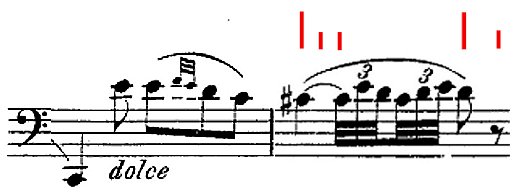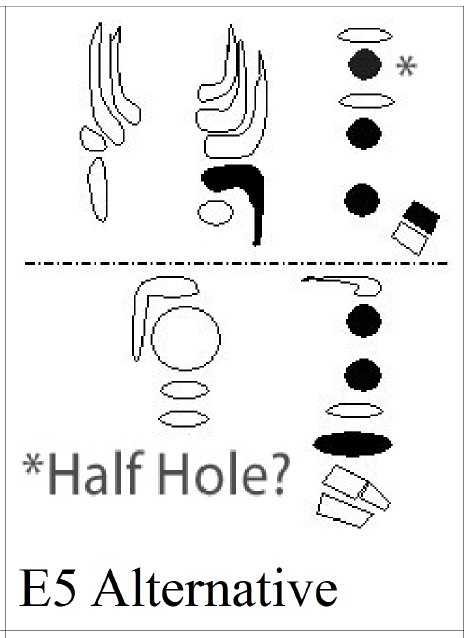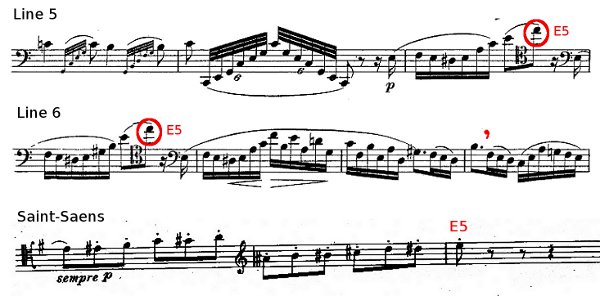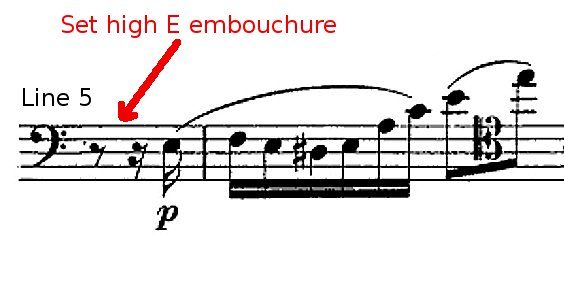Weissenborn Opus 8/2,
Study #50A
for advanced bassoon students. Fingerings for E5, high E.
Techniques for performing E5 including modifications to
bassoon bocals. References to music with E5 by Ravel,
Saint-Saëns, and Tansman are also made. Embouchure adjustments
for high register and muted playing. Also special thanks given
to Arthur Grossman. By Terry B. Ewell, Bassoon Digital
Professor. BDP#158. www.2reed.net.
Loaded 2reed.net and Youtube 21 May 14
https://www.youtube.com/watch?v=6fy5J4paDQc
维斯伯恩 练习曲视频 50A (Practicing Weissenborn Study #50A)
《维斯伯恩高级练习曲》第50首,A部分
维斯伯恩作品Op. 8/2,第50首,A部分,为高级巴松学生而做。这首练习曲的侧重点在E5,高音E的指法。演奏E5的技巧包括调整巴松S管(弯管)。含有E5的参考乐段包括拉威尔、圣桑以及汤斯曼的作品。同时涉及高音区及演奏弱音时吹嘴的调整。特别感谢亚瑟.格罗斯曼。唐英伟博士,巴松管数码教授,BDP#158。www.2reed.net
Translated by Xiao Liang
TUTORIAL教程
Welcome, this is Terry Ewell. Study #50 presents many challenges and opportunities. The virtuosic riffs of scales and arpeggios need to be practiced for smooth fingerings and accurate timing. I prefer to shape the scales by lingering a bit more at the bottom and then moving the scale forward at the top. In slow motion it sounds like this:
你好!我是唐英伟。第50首练习曲里包含很多挑战和机会。那些华丽的音阶和琶音需要很多练习,这样我们能够熟练地运用指法并有精准的时机掌控。关于音阶,我喜欢在低音时留出一些空间然后把它们推进到高音。把速度放慢时听起来是这样的:

The breaths given in lines 1 and 2 and in the last line are quick “catch” breaths. Don’t make too much space in the music.
第一行、第二行和最后一行换气的时候要快速地偷偷换气,不要在音乐中留出太多空间。
Many of my students have trouble counting out correctly the first measure of line 2. Be certain to hold the quarter note out for the duration of two eighth notes. The two triplets are notated in a confusing manner. These six notes need to take place in the span of a single eighth note. Let me play the last measure of the first line and this measure with the metronome.
我的很多学生在第二行第1小节数拍子时遇到困难。一定要把四分音符保持为两个八分音符的长度。两个三连音的标注方法让人感觉混乱。这六个音要在一个八分音符的时值内吹完。让我用节拍器为你示范一下第一行的最后一个小节和这个小节。

This study presents E5 or high E. Similar to Eb5, this is a difficult note to perform on the German system bassoon. Here are my favorite fingerings for the note without using an E key:
在这首练习曲中,我们遇到了E5或者高音E。和降E5相似,在德系巴松上,这个音也是很难吹奏的。这是我最喜欢的不使用E键演奏这个音的指法:


Some bassoons such as the one I am now playing have an E key. My E key is in an offset position, which I really like. This allows for opening the E key with either my first or second finger.
一些巴松,比如我现在使用的这个,都有一个E键。我的E键在一个偏移的位置,其实我很喜欢这样。这样我就可以用我的一指或二指演奏E键了。
This is a wonderful key placement for the solo in the first movement of the Ravel Piano Concerto in G major.
这是在拉威尔《G大调钢琴协奏曲》第一乐章的独奏乐段中很关键的音符。 2.
这是我正常的高音E指法。我会在图表中显示这个正常而不偏移的E键位置的指法。
Here is my normal high E fingering. I will show the fingering in the chart with the normal position of the E key--not offset.
这是我正常的高音E指法。我会在图表中显示这个正常而不偏移的E键位置的指法。

Many performers make use of a special bocal for high notes. Sometimes a very cheap bocal works well for this. Other bocals are manufactured to increase the ease of performing high notes. For instance, years ago I purchased an “All Good” bocal that I used during my student days for high notes. It was a great help for these high notes.
Now I use another bocal for the high register, E5 or higher.
很多演奏者在吹奏高音时使用特殊的弯管。一些时候很便宜的弯管就可以胜任。其它弯管使得演奏高音变得更容易。例如,几年前我买过一个“各方面都好”的弯管,我在学生阶段一直使用它来演奏高音。这真的对高音起到了很大作用。
Bassoonists have discovered that drilling a very small hole using a 1/64 (0.156 mm) drill that is half an inch (12.7 mm) from the tip of the bocal greatly helps with the response of notes in the high register. However, if the hole is left open, the lower registers of the instrument suffer. A piece of tape or tubing over the hole is needed when it is not used for high notes.
巴松演奏者们发现,使用1/64 (0.156 mm)的钻头在距离弯管顶部半英寸(12.7
mm)的地方钻出一个非常小的孔,能够在演奏高音区时获得更好的响应。但是,如果这个孔一直开着,那么乐器的低音区会受到影响。这时,当不演奏高音区时,你需要用一块胶带或者管子盖住这个孔。
However, there is even a more ingenious solution. Arthur Grossman and a student developed an articulation mechanism that opens the vent when the D key is depressed. I use this bocal when I perform works in the extreme high register on the bassoon. The bocal also reminds me of the wonderful instruction and mentorship I received from Arthur Grossman.
然而,还有一个更加巧妙的解决方案。亚瑟.格罗斯曼和一个学生发明了一个发音机关,它能够在按下D键时打开出气孔。当我需要在巴松上很高的音区演奏时,我就会用这种弯管。这个弯管也时常让我想起我从亚瑟.格罗斯曼那里所受益的指导和教学。
I have made mention of my teachers who have contributed ideas in the other videos. However, Arthur Grossman is mentioned only in video #15 (BDP #123). This is not because he didn’t have a great influence on my bassoon playing, but rather because my teaching and understanding of the instrument was so formed by his instruction that it is impossible for me to separate his instruction from my own. I owe so much to him that his name would need to be constantly mentioned.
我曾经提到过我的老师在其他的教学视频中提出过建议。然而,亚瑟.格罗斯曼只在第15号视频(BDP#123)中被提及。这并不是因为他对于我的巴松演奏所起的作用不大,而是因为我对于这个乐器的理解以及教学方法是在他的教导下形成的,所以很难把我的理论和他的分离开。我所欠他的太多了,所以我需要不断地提起他的名字。
An alternative method is to reset your embouchure before each high E and put your teeth lightly on the reed. You will need to experiment with where the teeth are placed on the reed. Generally they will be a few millimeters away from the collar of the reed. Here is the fingering that is most often used for this technique.
另一种方法是在每次吹奏高音E之前重新调整你的吹嘴位置,并把牙齿轻轻地放在簧片上。你需要尝试一下把牙齿放在簧片的什么位置。一般来说,应该距离簧片的颈圈有几毫米。这里是使用这种技巧时通常会用到的指法。

Using your teeth on the reed and this fingering for producing the high E actually works quite well for the end of the Tansman Sonatine. It also works fine for the E5 in line 7 and at the end of the study.
把你的牙齿放在簧片上以及用这个指法吹奏高音E在汤斯曼《小奏鸣曲》的结尾很适用。同时,也适用于这首练习曲第七行的E5。

However, if you have a chromatic approach to high E or slur into it without a big leap, this method doesn’t work well. For instance, use the other fingerings for the E5s in lines 5 and 6 or the high E at the end of the Saint-Saëns Sonata, second movement. I find that the highest notes on the bassoon such as C#5, D5, Eb5, and E5 require several fingerings. I choose the one that works best for the situation.
但是,如果你通过半音吹到高音E或者通过没有大跨越的连线到达这个音,这个方法就不太适用了。比如,在这首练习曲第五和第六行的几个E5音或者圣桑的奏鸣曲第二乐章结尾使用其他的指法。我发现巴松上最高的几个音,例如升C5,D5,降E5和E5都需要不只一种指法。我通常会根据具体情况来选择最合适的那一种。

In this study, however, I just use my standard high E fingering.
然而,在这首练习曲中,我只是使用了标准的高音E指法。
The successful performance of Study #50 depends in large part on embouchure placement. In line 7 Weissenborn presents some of the greatest embouchure challenges you will be confronted with in bassoon literature.
能否成功演奏第50首练习曲很大程度上取决于吹嘴的位置。在第七行中,维斯伯恩为你呈现了一些你将来会在其他巴松乐曲中遇到的、很有挑战性的吹嘴位置的练习。
Large leaps on the bassoon are best accomplished by setting the teeth parallel with each other. In other words, I move my lower jaw forward slightly so that my lower teeth and lips are even on the reed with my upper teeth and lips. For instance, for the two E5s in lines 5 and 6 I need to set my parallel embouchure in position prior to the notes that lead to the High E5s.
对于巴松上需要演奏的大的跨越,最好的方法是把牙齿平行放置。换句话说,我稍稍向前移动我的下颚,这样在簧片上,我的下排牙齿与嘴唇就和上排牙齿与嘴唇处于同一个平面了。例如,在第五和第六行的两个E5音上,我需要在吹奏高音E5之前的几个音以前摆好平行吹嘴位置。

Position 1A in the figure best presents the embouchure that I use. I realize that this sacrifices the normal sound for the other notes, but I compensate for it with vowel placement and embouchure looseness.
图中1A的位置最好地展示了我所使用的吹嘴。我意识到,这种方案其实牺牲了其他音的正常声音,但我会用妥善处理元音的位置以及松动吹嘴来补偿这个小损失。

Now, immediately after the E5 in line 7 I set my embouchure for a more muted timbre. Embouchure position 2C best represents this embouchure position. I love this section because I can now express such a different mood. Thus, in the second measure of line 7, I pull the reed out of my mouth thereby obtaining a darker and tenderer sound. I do this throughout the whole piano section to provide as great a contrast as possible.
现在,在第七行E5之后,我立刻需要把吹嘴设为类似静音的音色。吹嘴位置2C表示了这个吹嘴位置。我喜欢这一段,因为我可以表现这样一种不同的情绪。因此,在第七行第2小节,我把簧片从口中拿出,从而获得更暗和柔和的音色。在这整个弱的乐段,我都如此处理的,这样就能够尽可能地得到鲜明的对比。

For the rest of the study, which is in a bravura style, I have slightly more reed in my mouth than my normal embouchure position. This provides a more vibrant and forte sound. Embouchure position 2A best approximates that embouchure position.
这首练习曲后面的乐段是炫技乐段,比起正常的吹嘴位置,我口中的簧片稍微多了些。这样会使我获得更亮和强的声音。吹嘴位置2A最恰当地展示了这时的吹嘴位置。
Previously I addressed differences in embouchure in Study #34 (BDP# 142). Please look at this if you have not viewed that video.
在之前的第34号练习曲(BDP#142)中,我讲述了吹嘴部分的不同。如果你还没有看过那个教学视频,请查阅。










